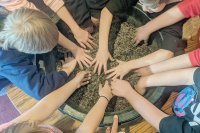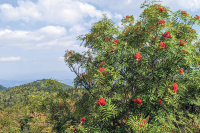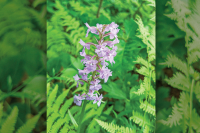America, mile by mile: Cross-country trip reveals country’s beauty, diversity
 A rainbow falls across Yellowstone Lake in Wyoming. Holly Kays photos
A rainbow falls across Yellowstone Lake in Wyoming. Holly Kays photos
Back when the trip was a new idea, I don’t think either of us took it seriously. Three weeks on the road, at a time when most American cars were sitting idle in the driveway? Thousands of miles of driving through sand and snow, mountain and desert, far from home? Surely this was just a pie-in-the-sky dream borne from the hunger pangs of quarantine, nothing more.
But the more we thought about it, the more reasonable the idea became. Brilliant, even. Gas was cheaper than it had been in decades, and the world was better adapted to remote work than ever before. If we were ever going to do a trip like this, now was the time to do it, and if we were going to travel at all in this most unconventional of years, this was the way to do it. No airplanes, no cruise boats, no cities — just the two of us in a car, driving through the changing country.
The concept was this: load up my husband’s 4Runner with camping supplies and outdoors gear, get a pre-emptive oil change, and hit the road for a three-week blitz of this nation’s greatest natural treasures, relying on U.S. Forest Service and Bureau of Land Management holdings for free lodging along the way. Two weeks after deciding to take the plunge, we were on Interstate 40, with no plans to leave it until reaching the desert. Rough itinerary? West to the Grand Canyon, north to Idaho, east to the Badlands and then a hard push back home to the Smokies. It was a back-of-the-napkin kind of plan, but we figured we’d fill in the details along the way.
That drive to Arizona marked the fifth time I’d traveled across the country in a car. The first and second time I was 16, riding in the middle seat of the family minivan from Maryland and through Indiana, Illinois and Iowa to South Dakota and Wyoming, returning via Nebraska. The third time I was 23, taking the Nebraska route once again on my way out to Idaho for an internship that would become my first foray into the newspaper business, and the fourth I was 25, driving solo through Kansas from my then-home of Buffalo, Wyoming, toward a new job in a place I’d never been before called Waynesville, North Carolina.
No matter the route, I’ve always found a cross-country drive to be downright awe-inspiring, and this was no exception. The green-covered Smokies smoothed into the rolling pasturelands of Tennessee, which, after passing through Memphis and crossing the Mississippi River, gave way to the lower, wetter, swampier terrain of Arkansas. Oklahoma began with the saturated verdancy of farmland in the golden light of evening but emerged on the other end of the night as a more austere version of itself, the superfluous portion of that former greenery done away with.
The trend toward dryness continued as we traveled across the northern tip of Texas, stopping in Amarillo between the windmill-laden horizons and golden-grained-fields for baskets of brisket and Cadillac Ranch, an only-in-Texas type spot where 10 old Cadillac frames dive nose-down in the earth, covered with probably thousands of layers of bright-colored spray paint. Soon New Mexico welcomed us, the scrub growing ever sparser as we caught our first glimpses of the geological chaos that was to come — mesas on the horizon, abrupt rocky gorges in the ground.
Related Items

My husband and I take a ‘self-portrait’ at the Canyon Overlook in Zion National Park.
Our Smoky Mountains are amazing, but they are but one stripe in the variegated tapestry that is America.
By the time we approached our first camp spot, in the Cibola National Forest near Albuquerque, we’d been driving for two hard days — nearly 1,500 miles — and were eager to get on with doing what we’d come to do: camp and explore. We found ourselves amid a gentle string of mountains rising from the scrubland, complete with trees and a pleasant place to pitch our tent, cook a simple meal and watch as the desert stars popped out above us.
But then the wind happened. Our day began at 4 a.m. after ongoing gusts splintered one of the tent’s fiberglass poles, causing us to wake up with the canvas pressed horizontally across our faces. As a result, we made an early exodus from the site and arrived at Petrified Forest National Park in Arizona around 9 a.m., encountering cool morning air and uncongested paths to take in the colorfully eroded landscape, which was studded by a rainbow of mineralized trees left over from a time when these deserts were swamps, dinosaurs walked the earth and human society was unknown.
Nothing, however, could have prepared us for the sight that waited just three hours to the northwest — the Grand Canyon. They say that nothing prepares you for the Grand Canyon. That no picture can capture it, no words convey it. That is completely true.
At the canyon rim, the world as we know it stops, and another world begins. This world’s genesis rested nearly a mile below our feet where the Colorado River flows blue-gray through arid land, forming a base from which rise cliffs, plateaus, mesas and more cliffs. They are gray, white and red, with a smattering of green. It all depends on where you look, and it’s impossible to tell what’s big, what’s small or how far away anything is. The closest thing you can get to scale is the hikers walking the Bright Angel Trail, which starts at the rim and ends 7.8 miles later at the river. Depending on which section of the trail you’re looking at, they look either like mice, ants or dust.
It’s a long drive from Waynesville to the Grand Canyon, and we still had two more weeks of exploring left to do. But after spending an afternoon on the edge, my feeble mind churning to comprehend the chasm before me, I felt that if we’d turned around right then, the drive would still have been worth it.
But the Grand Canyon was only the opening act of the geologic drama ahead of us. After a steadying evening beneath the Ponderosa pines of Kaibab National Forest, coyotes howling all around, we found our way out of the woods using gravelly Forest Service roads that eventually led to a dried-out land where red sand drowned out the few hardy grasses that managed to cling to life. From there, an unpaved BLM road took us on a seemingly endless journey through the unrelenting sun of Vermillion Cliffs National Monument, where scrubby shrubs and barely-green grasses teased the idea that an ultimately nonexistent oasis could be right around the corner, and then we finally crossed into Utah, our new camp trading the Ponderosa pines of Arizona for the more slender lodgepole.

Prayer flags and feathers wave in the breeze atop Black Elk Peak in South Dakota.

The ‘goblins’ of Goblin Valley State Park in Utah are the result of unevenly eroded sandstone layers.
It was 39 degrees when we awoke the next morning and set out for nearby Zion National Park, a paradise of life and water after that parched journey through the desert. Bare and rock-built slopes rose with severity around the hidden valley, prompting me to wonder what kind of person might ever dare to climb them. When we left at 3 p.m., the thermometer said 95 degrees. It was time to rest, at least until the sun grew low enough for an evening journey through the maze of towers called Bryce Canyon National Park. That canyon of rocky turrets glowed red-pink in the waning sun, and I tried to imagine what it must have been like to come upon this place as an early explorer or pioneer, the shock it must have been after months of travel through dusty deserts and open prairie. We modern folk often like to mock the fantastical beliefs of our forebears, but after stumbling upon a place like this, any reality must have seemed possible.
A morning of eggs and pancakes fueled us for a journey to the next jewel in Utah’s crown, Capitol Reef National Park, where early Mormon settlers had once grown fruit orchards — still maintained by the National Park Service — in the fertile land sandwiched between the angled results of tectonic collision. The rocks burned with warmth as the sun descended, and we made our way to the opposite side of the ridge, where sandy BLM land offered an expanse of options for pitching a tent, and for watching the sun set inside the sheets of rock enclosing Capitol Reef.
While the drive from North Carolina to Arizona features a steady progression of landscape, temperate rainforest giving way to prairie and then to ranchland and then to desert, Utah is simply chaos. From the explosive rockfaces of the Grand Staircase-Escalante National Monument to the grandeur of Zion to the spires of Bryce Canyon, it’s as though somebody found a way to etch a geologist’s wildest flights of fancy into stone. The trend held as we explored the totem-like sandstone formations at Goblin Valley State Park, drove through the diagonally emerging remnants of the San Rafael Swell and explored an unexpected canyon where black-stained walls dwarfed our paltry human bodies.
Heading north, we eventually witnessed a return of green-sided mountains and grassy yards, soon followed by the arrival of snowcaps in the distance. After crossing the Idaho line, the Tetons emerged like a snow-stained sunrise on the horizon, growing bigger and taller the closer we drew.
Soon enough, the snow came down from the mountains to meet us, mixing with rain as we slept in the car at a campground in Yellowstone National Park after an unforgettable evening at Old Faithful and the Geyser Basin, typically packed attractions that, thanks to this year’s disrupted travel plans, were nearly empty. The snow overcame the rain as we climbed up in elevation. It covered the lodgepoles with a thin layer of white and spiked the air with that cold and slightly piney scent I’d come to love during my former life in this part of the world. A layer of white, slippery slush covered the boardwalk at the colorful mineral pools known as the Artisan Paintpots, which we, once again, had nearly all to ourselves.

Steam hovers over the Geyser Basin in Yellowstone National Park.
By the next morning, the clouds had cleared, and the sky was once more covered with blue. We drove toward the Tetons and walked along the alpine waters of Jenny Lake and between the boulder fields lining the sides of Cascade Canyon. Four moose and two black bears — a momma and her cub — joined us for the excursion. It was a fitting farewell, because the next day we left the Tetons in the rearview, driving up and over the long and lonely Togwatee Pass, through the log-built town of Dubois and then the Wind River Indian Reservation, the snow-covered peaks of the Wind River Range rising to the south as we traveled through the arid basin. This eventually brought us to the Bighorn Mountains, where U.S. 16 winds up the sheer rock cliffs of Ten Sleep Canyon to Powder River Pass — elevation 9,666 feet — and past lodgepole stands that back up to meadows dotted with blue-purple lupins and the sunflower-like yellows of the arrowleaf balsamroot Cloud Peak and its snow-capped compatriots rise in the distance.
Some more hiking and exploring through the mountains and little town of Buffalo, and yet again it was time to move on, this time north and east past the abrupt column of volcanic rock that is Devils Tower and to the rolling and pine-clad Black Hills — back to Ponderosa for the first time since Arizona — home of South Dakota’s state bison herd, the ever-in-progress Crazy Horse sculpture and the chiseled jaws of Mount Rushmore. The hills are also the home of Black Elk Peak, which at 7,242 feet is the highest point east of the Rockies and west of Europe’s Pyrenees Mountains. A difficult but worthwhile 7-mile roundtrip hike let us stand atop Harney Lookout Tower, a Civilian Conservation Corps construction that sits on the peak, blue-and-cottonball skies spreading all around.

The Absaroka Mountains rise in the rearview heading into Dubois, Wyoming.

More than 1,000 bison roam Custer State Park in South Dakota.
In terms of area, the United States is the world’s fourth largest country, its 3.5 million square miles of land comprising just over 6 percent of the world’s landmass. It is three times the size of India, six times the size of Mongolia, 20 times the size of Spain and more than 30 times the size of Italy.
I think these are facts that fall in the category of “easy to know, hard to understand.” I know and have known since I was in elementary school that the U.S. is huge compared to most countries in the world. Last year, I went to Spain and was mildly amazed that, upon flying into the center of the country, it was possible to get most anywhere on the outskirts after an easy day’s drive of six hours or so. Meanwhile, from North Carolina you can flick on the cruise control and drive for days — literally, for days — before any ocean or border checkpoint stops you.
But really, it takes driving across this country — our country — to truly understand how huge it is, how diverse it is, how incredible it is that this enormous place can be at once so varied and so similar across its vast expanse. Isn’t it amazing that I can spend my cash here in N.C. or 3,000 miles away in California, with no need to visit a money changer? That my speech is understandable in the Appalachians as well as in Alaska? Or that we’re all Americans, and yet we’re formed by such different forces, depending on which part of the nation we call home?
How could the subway-riding marketing assistant who lives in a closet-like apartment in New York City, barely surviving on $50,000 a year, ever understand the ways in which her norms might confound those of the weathered rancher from Wyoming, who has never seen a city larger than Cheyenne but sure knows what to do when a whiteout blizzard crops up riding the range alone? Vice versa? They will always occupy separate worlds, at least until the marketer plans a stay in small-town Wyoming, or the rancher ventures to the Big Apple.
And that, I think, is what travel is all about — understanding.
Understanding the ground beneath us — where it came from and what it one day will be.
Understanding who our neighbors are, and how they live their lives on this hurtling ball of rock we all call home.
And understanding the interconnected communities that thrive on its surface — the plants, the insects, the birds, the mammals — all the living things whose lives intersect as they pace out their own path to survival on this land — America — that is their home, and ours too.













